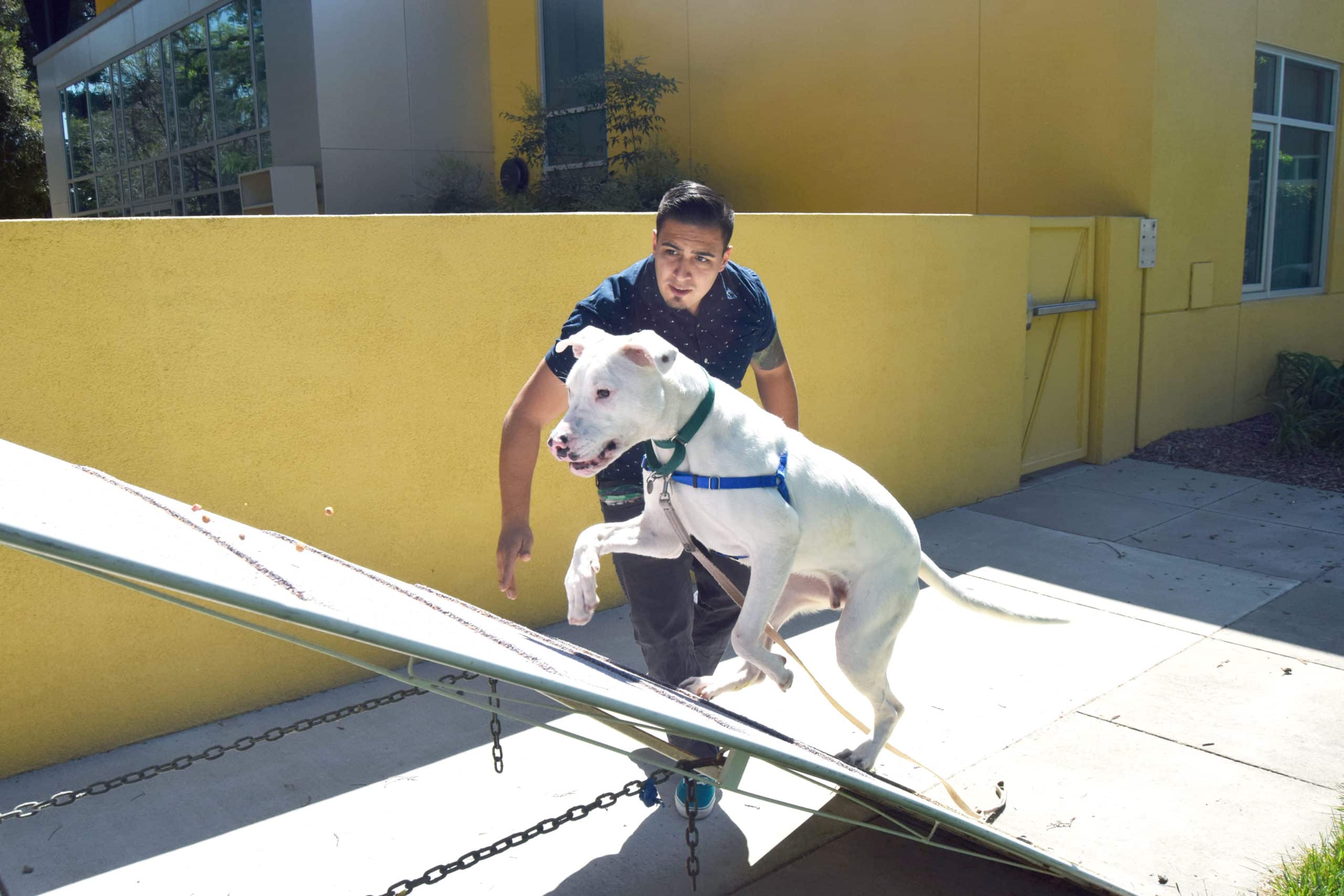
Emergencies come in many forms, and may require anything from a brief absence from home to a permanent evacuation. Preparation is key to a successful evacuation and each type of disaster requires different measures to keep your pets safe.
Stay calm. If you have to leave home suddenly, collect your wits and your pets. The behavior of pets may change dramatically after a disaster. Normally quiet and friendly cats may become aggressive or defensive. Watch animals closely. Your pet is very attuned to your emotional state. Try to keep your cool so your pets don’t panic. Speak firmly, but calmly. Once you’ve collected all your pets, you may want to place them in a separate room or in carrier so they don’t become panicked by all the activity.
Plan Ahead
- What types of disasters affect your area?
- Do you have advance warning before the disaster?
- What can you do to protect your pets in an emergency?
- What’s it like to rescue animals in a disaster situation—and how can you get involved?
- What are the most important things people can do to protect their pets in the event of an emergency?
- Does planning ahead really make a difference?
Expect the unexpected. No matter where you live, the unexpected can occur. Disasters come in all forms. From blizzards to wildfires, earthquakes and hurricanes, terrorist attacks to floods and tornados, emergencies occur in all parts of the country. Everyone should have a disaster plan for their family, including one for pets. Preparedness can help save lives. Pets are part of the family, and it’s imperative they be included in all family disaster plans. Remember, they’re counting on you.
Planning ahead can make all the difference in order to be properly prepared to leave a disaster area with your pet. At hand and ready to use should be leashes, muzzles, and carriers for each pet. A full supplies list can be found in this section. The key to a successful departure is to have resources available with which to transport your pet safely when you have a short window of time in which to evacuate.
In the unfortunate situation where you can’t get home in time, designate a caregiver to evacuate your pets on your behalf. All pets should already be microchipped with collars and identification tags. Keep your contact information up-to-date on tags and microchip database, and maintain current photographs of you and your pets, in case you become separated.
Have a safe haven already lined up to go, outside of your immediate home area. Discuss in advance the possibility of sheltering. If you don’t have friends or family outside of your local area, locate pet-friendly hotels outside of your area, before disaster strikes. Keep phone numbers with other important contacts, as emergency evacuation shelters should be your last resort.
City or County Disaster Programs
Does your city or town have a disaster program plan? Research which groups exist and the name of the leader. Check with the local non-profit humane societies in your area to see if they have their own plan and an animal evacuation group. Other agencies to check include Animal Control, City Hall, local chapter of American Red Cross, Fire Department or Law Enforcement. Perhaps there’s a Search and Rescue team in the area – they might have a plan and don’t forget to ask the local librarian – they’re a wealth of information. It’s not difficult to find human planning, but it’s rare to find this type of planning for animals.
Safe Haven
Arrange a safe haven for your pets in the event of evacuation. Do not leave your pets behind to fend for themselves. Remember, if it isn’t safe for you, it isn’t safe for your pets. They may become trapped, escape, or be exposed to numerous life-threatening hazards. Red Cross disaster shelters will not accept pets because of health and safety regulations, so it is imperative you have determined where you will take your pets ahead of time. Options include:
- Contacting your veterinarian for a list of preferred boarding kennels and facilities
- Asking your local animal shelter if they provide emergency shelter or foster care for pets
- Identifying hotels or motels outside your immediate area that accept pets
- Asking friends and relatives outside your immediate area if they would be willing to care for your pet
Designated Caregivers
Consider designating a caregiver who can help your pet in the event you cannot get home. When choosing a temporary caregiver, consider someone who lives close to your residence. This person should be someone who is generally home during the day while you are at work or has easy access to your home. A set of keys should be given to this trusted individual, along with feeding and care instructions for all pets and your veterinarian’s name. This may work well with neighbors who have pets of their own – you may even swap responsibilities, depending upon who has accessibility.
When selecting a permanent caregiver, you’ll need to consider additional criteria. This is a person to whom you’re entrusting the care of your pet in the event something happens to you. When selecting this “foster parent,” consider people who have met your pet and have successfully cared for animals in the past. Be sure to discuss your expectations at length with a permanent caregiver, so he or she understands the responsibility of caring for your pet.
Emergency Supplies & Travel Kit
Keep an Evac-Pack and supplies handy for your pets. Make sure everyone in the family knows the location of your Evac-Pack. This kit should be clearly labeled and easy to carry. Items to consider keeping in or near your pack include:
- Pet first-aid kit and guide book
- 3-7 days’ worth of canned (pop-top) or dry food
- Disposable litter trays (aluminum roasting pans)
- Litter or paper toweling
- Liquid dish soap and disinfectant
- Disposable garbage bags for clean-up
- Pet feeding dishes
- Extra harness and leash
- Photocopies of medical records and a waterproof container with a two-week supply of any medicine your pet requires. Remember, food and medications need to be rotated out of your emergency kit — otherwise they may go bad or become useless.
- Muzzle
- Bottled water, at least 7 days’ worth for each person and pet (store in a cool, dry place and replace every two months)
- Traveling bag, crate or sturdy carrier, ideally one for each pet
- Flashlight
- Toys
- Poop Bags
- Calming Medication
- Booties (foot protection)
- Blanket (for scooping up a fearful pet)
- Laminated photographs of your pets (in case you are separated and need to make “Lost” posters)
- Cats: Pillowcase or EvackSack, toys, scoopable litter
- Dogs: Long leash and yard stake, toys and chew toys, a week’s worth of cage liner
Evacuation Preparation
If you must evacuate your home in a crisis, plan for the worst-case scenario. If you think you may be gone for only a day, assume you may not be allowed to return for several weeks. When recommendations for evacuation have been announced, follow the instructions of local and state officials. To minimize evacuation time, take these simple steps:
- Visit Pet-Friendly-Hotels.net for a list of pet-friendly hotels and motels in your area. Ask if they have a restriction on size or number of pets.
- Call local boarding kennels and veterinarians with boarding facilities. Ask about their ability to house animals in case of emergency and/or disaster.
- Store an emergency kit and leashes as close to an exit as possible
- Make sure all pets wear collars and tags with up-to-date identification. Your pet’s ID tag should contain his name, telephone number, and any urgent medical needs. Be sure to write your pet’s name, your name and contact information on your pet’s carrier
- ARF recommends microchipping your pet as a more permanent form of identification. A microchip is implanted in the animal’s shoulder area, and can be read by scanner at most animal shelters
- Always bring pets indoors at the first sign or warning of a storm or disaster. Pets can become disoriented and wander away from home during a crisis
- Consider your evacuation route and call ahead to make arrangements for boarding your pet outside of the danger zone at the first sign of disaster.
If You Must Leave Your Pet Behind
Leaving your pet at home will place your animal at greater risk for injury or loss, so make every effort to take your pet with you. If you have no alternative but to leave your pet behind, there are some precautions you must take:
- Give your pet access to a safe, secure room without windows but with adequate ventilation, such as a bathroom.
- Leave enough food for at least three days. A sufficient supply of water is critical (one animal can easily drink several gallons of water a day when under stress). Place water in containers that aren’t easily knocked over, and leave a faucet dripping into a bathtub or sink with an open drain.
- If you expect flooding, provide access to elevated spaces or counters. Leave familiar bedding and safe toys.
- Don’t confine dogs and cats in the same space. Keep small animals and birds safely caged. Secure bird cages so they won’t swing and fall. Never leave a dog tied outside.
- Make sure your pets are wearing proper identification (a collar and tag).
- Place a notice on your front or garage door advising what pets are in the house and where they are located. Provide a telephone number where you or a contact can be reached, as well as the name and number of your vet.
Additional Resources
The American Veterinary Medical Association’s Disaster Preparedness Series lists the following available materials:
- Saving the Whole Family booklet
- The Centers for Disease Control offers information on chemical and biological agents and radiation
- United States Environmental Protection Agency offers emergency response guidelines for natural disasters
- Federal Emergency Management Agency
Header photo courtesy of FEMA Photo Library



